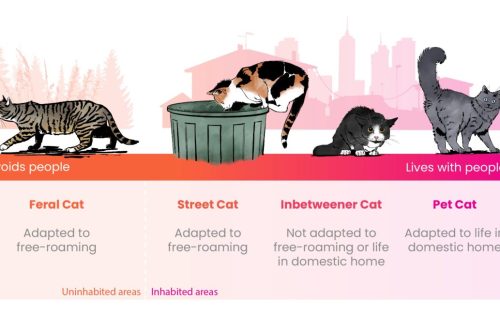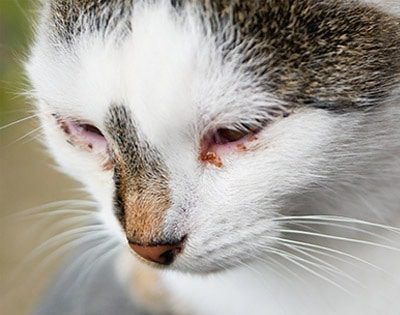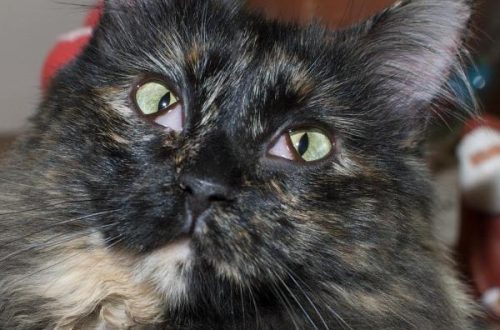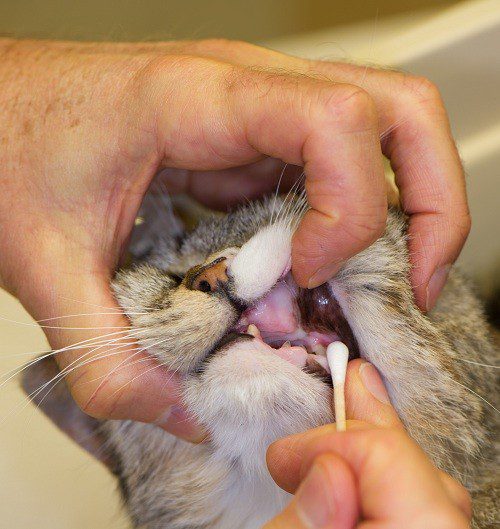
Tartar in cats: removal and prevention
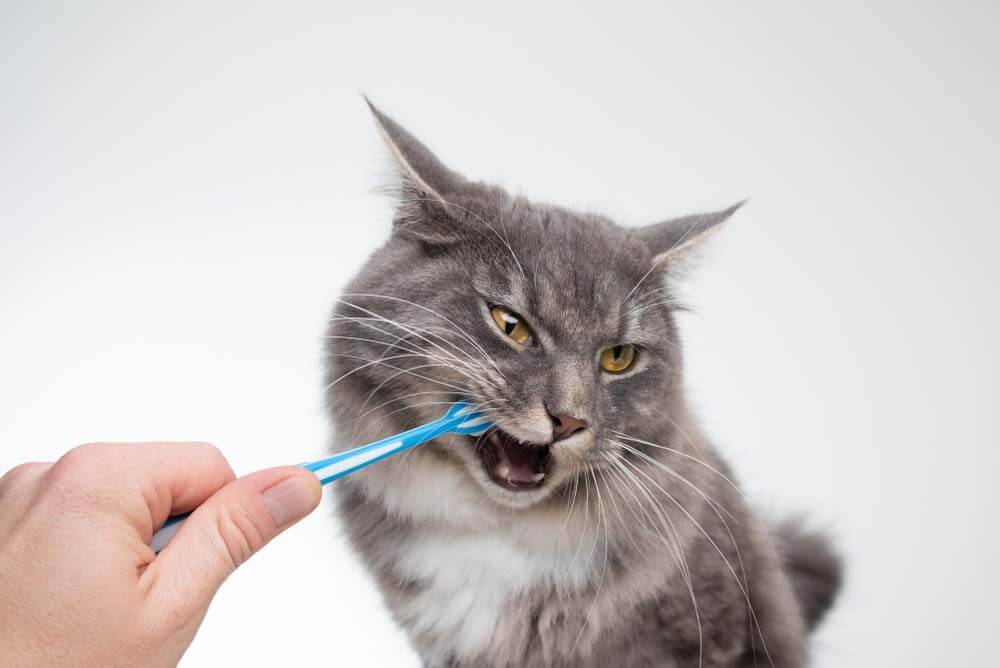
Contents
Stones on the teeth of cats: the main thing
Tartar is brown or yellow growths on the teeth that are made up of bacteria, food debris, and lime deposits.
Dental deposits harm not only the oral cavity, but also the digestive organs, the respiratory system and even the eyes.
The main reason for the formation is insufficient oral hygiene and gum disease.
The most susceptible to the formation of deposits on the teeth are cats of brachycephalic breeds (with a short muzzle) and cats older than 6 years.
The main symptoms are bad breath, reddening of the gums, characteristic plaque and growths on the teeth.
Diagnosis can be made by careful examination of the oral cavity.
Stone removal is possible only with an ultrasound scaler, other methods are effective only at an early stage.
Prevention consists in oral hygiene (teeth brushing, special food, use of toothpick treats).

What is tartar?
Tartar is a hard build-up on the teeth that is made up of a mixture of bacteria, limescale and food debris.
It all starts with the fact that in cats a plaque is formed on the teeth, consisting of food debris. Bacteria enter this environment, feel comfortable there and actively multiply.
Due to the vital processes of microorganisms (rotting, oxidation), an unpleasant odor comes from the mouth.
Bacteria always live in the oral cavity and are usually harmless, but when they multiply actively, they cause inflammation of the tissues. Plaque becomes denser and thicker over time, mineral compounds begin to settle in it, and due to this, it gradually hardens. The color of the stone can be from yellow-gray to brown, sometimes with green inclusions (due to the growth of fungi).
Depending on the microbiome and the type of salts, stones on the teeth of cats come in different densities. And they can form at different speeds. At the very beginning, plaque is soft and can be brushed off. But as it hardens, due to the vital processes of bacteria, the stone will cover an increasing area of the tooth, strengthen and destroy the enamel. It is important to remember that tartar and plaque are formed not only on the surface of the tooth, but also in the subgingival space.
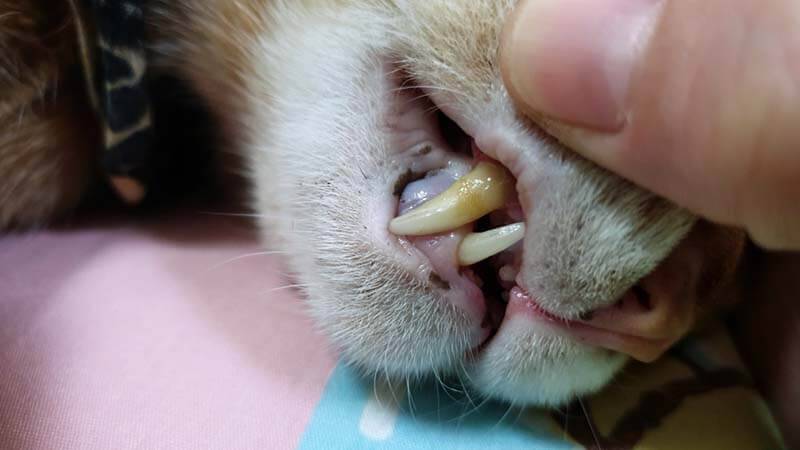
danger to the animal
Tartar is dangerous not only for the teeth and gums, but also for other organ systems of the cat. Let’s discuss the most common complications:
First of all, the oral cavity suffers. The enamel is destroyed, the constant presence of bacteria causes decay processes and provokes pathological processes (periodontitis, gingivitis, stomatitis, caries, periostitis). This is accompanied by redness and pain. Over time, if left untreated, teeth will begin to rot and fall out.
Inflammation of the roots of the teeth can turn into a flux or abscess in the muzzle.
Painful chewing will reduce appetite, and the animal will lose nutrients, which will affect its health.
Bacteria from the oral cavity constantly enter the gastrointestinal tract and respiratory tract, which increases the risk of diseases of these organ systems (enteritis, pneumonia, etc.).
Eye diseases. The cat licks itself, and the bacteria from the mouth constantly enter the mucous membranes of the eyes, which can provoke inflammation.
Rhinitis, rhinoconjunctivitis. The nasal cavity is located in close proximity to the oral cavity, they communicate in the pharynx. Thus, inflammatory processes in the mouth can easily provoke rhinitis (inflammation of the nasal passages). And rhinitis can turn into conjunctivitis due to the nasolacrimal duct, which runs between the nose and the inner corner of the eye. It is not uncommon for animals with advanced cases to have chronic discharge from the eyes or nose.
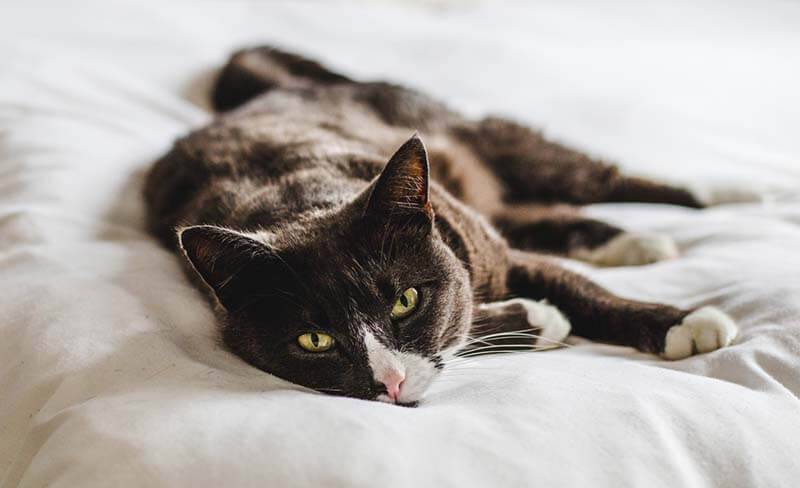
Causes of tartar formation
In cats, it all starts with plaque, which is formed from the remnants of food masses. Accordingly, the main reason for the formation of the stone is insufficient oral hygiene.
Additional factors are:
Soft food. Pates, mousses, cereals will be easier to settle on the walls of the teeth.
Small food granules. If the granules are not chewed but swallowed, there is no cleaning of the teeth and plaque progresses.
Age. By the age of 6-8 years, cats usually already have dental deposits. There is nothing wrong with that, you just need to get rid of them in time, until there are problems.
Diseases of the oral cavity. Firstly, if the pet has these diseases (gingivostomatitis, calicivirus, etc.), then he will not be able to chew normally, which will increase the formation of plaque. And secondly, there will be more bacteria in the oral cavity during inflammation, namely they are responsible for the hardening of plaque.
breed predisposition. The stone is more actively formed in animals with a flat muzzle due to the structural features of the jaw (more details below).
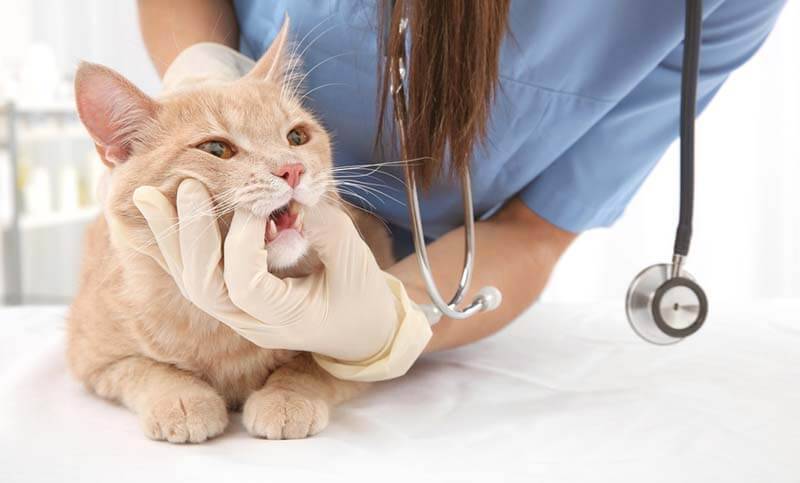
Who is at risk
Especially intensively tartar is formed in pets with a flattened muzzle (Persian, Exotic, British, etc.). Due to the peculiarities of the structures of the jaw, these cats often do not grasp food correctly and cannot chew it well. Also, they often have an abnormal arrangement of teeth, pockets and crevices are formed into which food is clogged and stone forms over time.
At risk and older animals. In them, as a rule, the stone grows asymptomatically for a long time, the owners may not notice it until the problem becomes acute. For cats older than 6 years, an annual check-up by a veterinarian is recommended (may be combined with vaccination).
Symptoms
The first symptoms are always bad breath and reddened gums. But the cat seems healthy. As the disease progresses, the signs of oral disease will increase and worsen.
Symptoms of tartar in cats (as it progresses):
bad breath (halitosis);
redness of the gums (gingivitis, stomatitis);
bleeding gums;
growths on the teeth that are yellow, gray or brown (sometimes greenish due to fungal growth);
chewing disorders – chewing on one side, gnashing;
decreased appetite;
swelling in the cheekbones and lower jaw;
pain when touching the gums or muzzle;
discharge from the eyes, nose;
excessive salivation (hypersalivation).
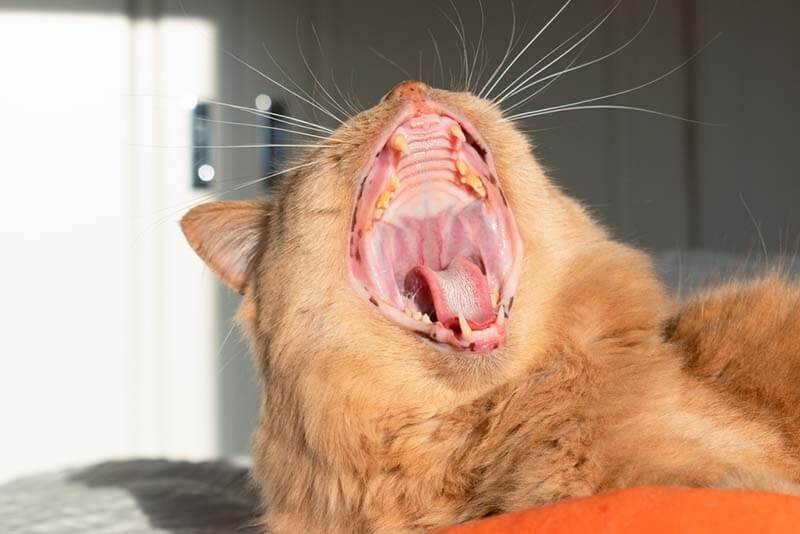
Diagnostics
Diagnosing tartar is very simple. With a wide opening of the oral cavity, it can be seen without special equipment, unless a flashlight may be required. Sometimes you need to move the gum a little.
Dental x-ray (dental x-ray) and cytology of the affected gum may be additionally required to diagnose complications associated with deposits on the teeth.
Removal of tartar in cats
Complete removal of tartar can only be carried out with the help of an ultrasonic scaler under anesthesia. All other methods are suitable for cleansing plaque or early stone (when it is still soft and can be brushed off).
The main means for removing tartar in cats are used:
Specialized feed
Foods designed to fight tartar really show their effectiveness, but only in the very early stages.
The bottom line is that the food has a certain size and texture of the kibble, due to which it sits on the tooth, and does not crumble right away, which helps to clean and massage the gums. Also in the composition of such diets, as a rule, there are components that reduce the formation of lime deposits. With significant growths, these feeds will not clean your teeth. In addition, there are hard-to-reach places on the teeth that most likely will not be cleaned to the end, and some cats even chew only with their front teeth.
Means for removing tartar
In the early stages, a paste or gel may be used to remove tartar in cats. These drugs are only effective when used correctly. They need to thoroughly brush their teeth at least once every 3 days.
There are also “toothpicks” that can be given as treats once a day. Their effectiveness and principle of action are the same as those of the feed. But it is important not to exceed the daily allowance, since they are composed of dense fibers and can cause diarrhea if taken in excess.
Various liquids in the form of sprays and plant-based gels will not help get rid of the stone, but will fight inflammation and have a healing effect on the gums.
Mechanical teeth cleaning
Here we mean cleaning with special tools at the veterinarian. Dental instruments are commonly used for this. Such cleaning will not get rid of subgingival calculus, will not clean the enamel properly and will not help remove deposits in hard-to-reach places. In addition, there is a risk of damage to the tooth itself. This method is not very effective and sometimes dangerous. After mechanical cleaning, the stone, as a rule, quickly grows again.
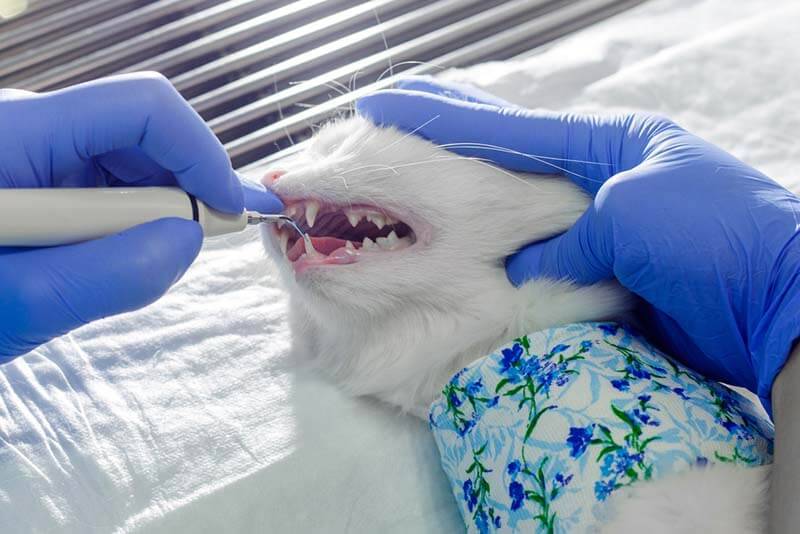
Sanitation (cleaning) with an ultrasonic scaler
The most effective way to get rid of tartar in cats is with an ultrasonic scaler. During sanitation, the doctor uses a special pen with a metal nozzle at the end. This nozzle emits ultrasound, and at the same time a thin stream of solution enters it from a special hole. Due to the combination of ultrasound and liquid, tartar is destroyed. The tooth itself is not damaged.
But not a single cat in its right mind will allow you to climb into your mouth with a whistling device, and even splashing water. Therefore, although the procedure is almost painless, sedation (light anesthesia) is used. In this way, you can avoid stress in your pet and thoroughly clean hard-to-reach places. After sanitation, it is recommended to polish the tooth enamel so that later tartar is formed as slowly as possible. The procedure is often performed in clinics and is well tolerated by animals.
Is it possible to remove the stone at home?
No stone removal method will be effective if there is already a lot of it. But during the period when plaque is just beginning to harden, it can still be removed with a special toothbrush and veterinary toothpaste.
A rare cat will allow this, but if the pet is taught to do this from childhood and properly encouraged after, then everything can work out.
Tartar Prevention in Cats
To prevent tartar in cats, you need to follow a few simple rules:
Oral hygiene. You need to brush your cat’s teeth with a brush on your own, once every 1-3 days or with a doctor with ultrasound – once every 1-2 years.
Drinking mode. Arrange several bowls and glasses of water around the apartment, especially where the cat likes to spend time. Change the water every day. If your pet likes to drink from the tap, consider purchasing a drinking fountain from a pet store. You can add a few drops of broth, wet food sauce, milk, or lemon juice to the water. But the most important rule is that the bowl of water should be kept away from the bowl of food.
Specialized food and treats-toothpicks. Their periodic use will slow down the formation of tartar or even prevent its occurrence.
Annual examination by a veterinarian. It can be difficult to notice the first dental deposits. The doctor will be able to more carefully examine the oral cavity and take action in time.
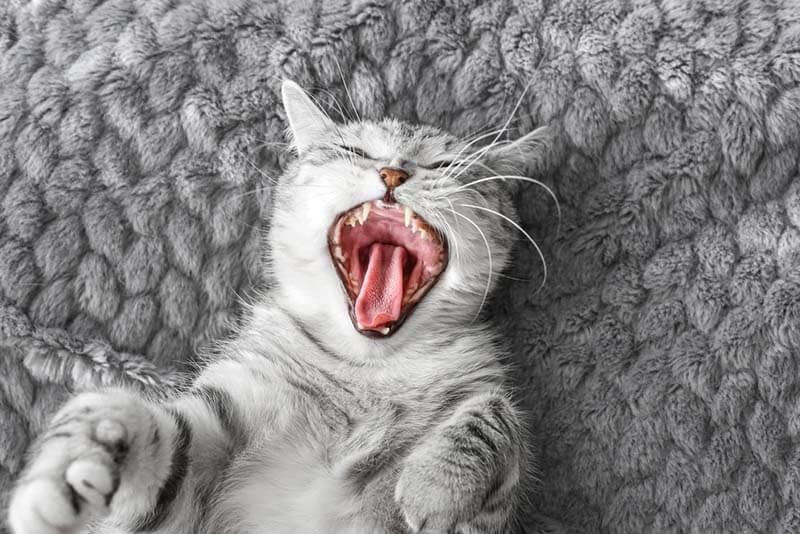
Answers to frequently asked questions
December 6 2021
Updated: December 6, 2021



